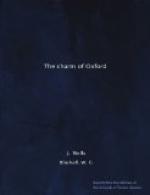It is refreshing to turn from the thought of so much dead industry, as these multitudes of unread books will represent, to the inspiration of the buildings. They are the very epitome of Oxford. The classic symmetry of Gibbs’ dome looks across at the soaring spire of the mediaeval University Church, while the Bodleian is one of the best examples of the Jacobean Gothic, which still held its own in Oxford when the classical style was triumphing elsewhere. Such contrasts are typical of Oxford. The University had a European reputation in the days when it was one of the two great centres of mediaeval scholasticism. Roger Bacon, the most famous name in mediaeval science, no doubt saw the tower of St. Mary’s beginning to rise. The University welcomed the Classical Revival, it survived the storms of the Reformation, it was the great centre of the building up of Anglican theology under the Laudian rule, it was one of the inspirations of English science in the seventeenth century, though Dr. Radcliffe’s generous benefactions are a little later, and have hardly begun to yield their full fruit till our own day. Such are the learned traditions of the Radcliffe Square, while it has also been the centre of the young lives which, for seven centuries at least, have enjoyed their happiest years in Oxford.
The view from the Radcliffe roof is undoubtedly the best in Oxford. It has been thus described by the worst of the many poets who have celebrated the University:
“Spire, tower and steeple,
roofs of radiant tile,
The costly temple and
collegiate pile,
In sumptuous mass of
mingled form and hue,
Await the wonder of
thy sateless view.”
But Robert Montgomery is more likely to be remembered for Macaulay’s merciless but well-deserved chastisement than for his praises of Oxford. Even their utter bathos cannot degrade a group of buildings so wonderful.
THE BROAD STREET
“Ye mossy piles of old munificence,
At once the pride of learning and defence.”
J. Warton, Triumph of Isis
The east side of the University buildings proper was shown in the last picture (Plate III); in the following (Plate IV), the north side of the same block is seen. The old University “schools” lay just inside the city wall, and Broad Street, which is there represented, occupies the site of the ditch, which ran on the north of the wall. This picture is a fitting supplement to the last, for the Sheldonian Theatre on the right of it and the Clarendon Building in the background may claim rank even with the Bodleian and the Radcliffe as the University’s special buildings.
The Sheldonian celebrated its two hundred and fiftieth anniversary only last year (1919), when the music which had been performed at its opening was performed once more. It is a building interesting from many points of view. Architecturally it marks the first complete flowering of the genius of Sir Christopher Wren. He was only thirty-seven when it was completed, and had been previously known rather as a man of science than as an architect; he was Oxford’s Professor of Astronomy; but Archbishop Sheldon chose him to build a worthy meeting place for his University, even as at the same time he was being called by the king to prepare plans for rebuilding London after the Great Fire.




